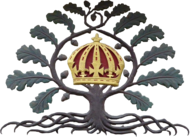Tories | |
|---|---|
| Leader(s) | |
| Founded | 1678 (first) c. 1783 (second) |
| Dissolved | c. 1760 (first) 1834 (second) |
| Preceded by | Cavaliers |
| Succeeded by | Conservative Party |
| Ideology | |
| Political position | Centre-right[4] to right-wing[5] |
| Religion | |
| Colours | Blue |
| Part of the Politics series on |
| Toryism |
|---|
 |
The Tories were a loosely organised political faction and later a political party, in the Parliaments of England, Scotland, Ireland, Great Britain and the United Kingdom. They first emerged during the 1679 Exclusion Crisis, when they opposed Whig efforts to exclude James, Duke of York from the succession on the grounds of his Catholicism. Despite their fervent opposition to state-sponsored Catholicism, Tories opposed his exclusion because of their belief that inheritance based on birth was the foundation of a stable society.[7]
After the succession of George I in 1714, the Tories had no part in government and ceased to exist as an organised political entity in the early 1760s (although the term continued to be used in subsequent years as a term of self-description by some political writers). About twenty years later, a new Tory party arose and participated in government between 1783 and 1830, with William Pitt the Younger followed by Robert Jenkinson, 2nd Earl of Liverpool.[8] The Whigs won control of Parliament in the 1831 election, which was fought largely on the issue of electoral reform, opposed by the Tories. The Representation of the People Act 1832 removed the rotten boroughs, many of which were controlled by Tories and the Party was reduced to 175 MPs in the 1832 elections.
Under the leadership of Robert Peel, who issued a policy document known as the Tamworth Manifesto, the Tories began to transform into the Conservative Party. However, his repeal of the Corn Laws in 1846 caused the party to break apart; the faction led by the Earl of Derby and Benjamin Disraeli went on to become the modern Conservative Party, whose members are still commonly referred to as Tories.
- ^ "A Brief History of the Conservative Party". Conservatives. 24 October 2007. Archived from the original on 13 March 2008.
- ^ Holmes, Geoffrey (1983). "Eighteenth-Century Toryism". The Historical Journal. 26 (3): 755–760. doi:10.1017/S0018246X00021178. JSTOR 2639092. S2CID 162328892.
- ^ "Making Sense of the Divine Right of Kings". 18 December 2020.
- ^ Andrew Whittaker, ed. (2009). Britain: Be Fluent in British Life and Culture. Thorogood Publishing.
- ^ James Frey, ed. (2020). The Indian Rebellion, 1857–1859: A Short History with Documents. Hackett Publishing. p. XXX. ISBN 978-1-6246-6905-7.
British politics of the first half of the nineteenth century was an ideological spectrum, with the Tories, or Conservative Party, on the right, the Whigs as liberal-centrists, and the radicals on the left.
- ^ Filby, Eliza (23 November 2013). "The death of Tory Anglicanism". spectator.co.uk. Retrieved 5 October 2024.
- ^ Harris (1993), p. 124.
- ^ Cooke, Alistair (August 2008). "A Brief History of the Conservatives". Conservative Research Department. Archived from the original (PDF) on 30 April 2010. Retrieved 27 April 2010.